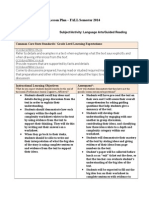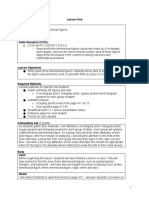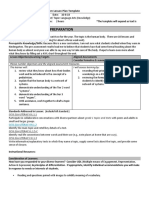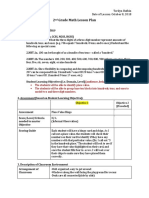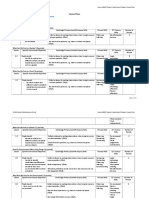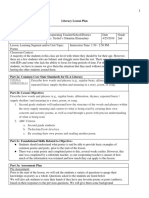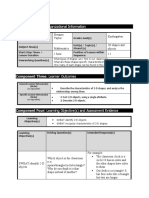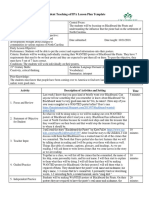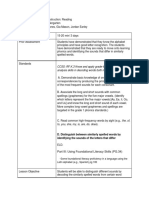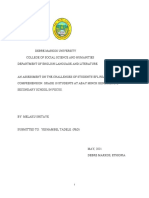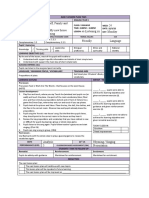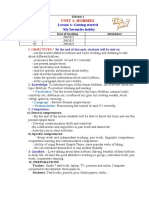Daily Lesson Plans
Daily Lesson Plans
Uploaded by
api-250145674Copyright:
Available Formats
Daily Lesson Plans
Daily Lesson Plans
Uploaded by
api-250145674Original Title
Copyright
Available Formats
Share this document
Did you find this document useful?
Is this content inappropriate?
Copyright:
Available Formats
Daily Lesson Plans
Daily Lesson Plans
Uploaded by
api-250145674Copyright:
Available Formats
DAILY LESSON PLANS Day 1 Lesson Monday Level: 4th grade Subject: Math Geometry Title: Developing Lines
es and Angles Vocabulary SOL(s): -Math 4.10: The student will a) identify and describe representations of points, lines, line segments, rays, and angles, including endpoints and vertices. WIDA Standard: ELP Standard 3: The Language of Mathematics, grades 3-5. English Language Learners will process, understand, produce, or use: Level 3: Developing: general descriptions of point, line, line segment, ray, angle, endpoint, and vertex. Situation Time: 5 mins Students will be shown basic examples of a point, line, line segment, ray, and angle. These figures will be projected onto the Smartboard for the duration of the situation. The students will work together in their groups to create gestures for each of the figures, without having been told the term name for each figure or having been given any other information. Students will work in groups of 4 or 5 during the situation. Students will work in pairs with their neighbor for the exhibit. The teacher will have the students return to their seats and ask the students if they have seen these figures before and she will activate their prior knowledge by asking the students what they may already know about these figures. The teacher will ask the students to share the gesture that they came up with for each figure from their seats while looking for any similarities or differences among the gestures. During this time the teacher will also name each of the terms for the figures shown. The teacher will then guide the students in creating a common gesture for each figure, which the class will then continue to use throughout the unit. These gestures will be practiced several times. The teacher will then introduce essential vocabulary by guiding students in deciding on a class definition for each term. Once a definition has been discussed for each term, the teacher will project the figure along with the definition on the smartboard, one at a time as each definition has been discussed. During the situation, the teacher will guide the students in coming up with gestures by asking them What similarities or differences do you see among the figures? During the bridge, the teacher will guide the students in coming up
Groupings Time: 1 min Bridge Time: 15 mins
Questions Time: n/a
Exhibit Time: 5 mins
Reflections Time: 3 mins
with a definition for each term. The teacher will ask: What does this figure look like to you? What do you notice about this figure? What does this figure have that other figures also have or do not have? What does the arrow mean? What does the dot mean? With a partner (neighbor), students will take turns gesturing to each other using mirrors while their partner states the term for the gesture. To the best of their ability, students will also state the definition/description of each term. Their partner will decide whether their definition is accurate or not. The teacher will pass out exit slips to the students so that they can complete the following prompts: I learned ___________. I am still confused about _______________. Modifications will be made for Level 3: Developing Point, line, line segment, ray, angle, endpoint, vertex Student will be able to describe each type of figure in their own words using a complete sentence. Flashcard set with picture of figure on one side and description on the other side Bilingual dictionary Student will receive a chart of figures next to real-world representations of the figures. Student will work with a partner during the gesturing and they will take turns explaining the definitions of each figure as they go along with the gesture. Teacher will walk around as the students gesture and define the gestures with their partner. Teacher will also look at their exit slip to see if they have been able to use the correct language and terminology to share what they know and are confused about.
ELL MODIFICATIONS Key Vocabulary Language Objectives Supplementary Materials Building Background Scaffolding Techniques/Interaction Review/Assessment
Day 2 Lesson Tuesday Level: 4th grade Subject: Math Geometry Title: Naming Lines, Line Segments, Points, Rays, and Angles SOL(s): -Math 4.10: The student will a) identify and describe representations of points, lines, line segments, rays, and angles, including endpoints and vertices. WIDA Standard: ELP Standard 3: The Language of Mathematics, grades 3-5. English Language Learners will process, understand, produce, or use: Level 3: Developing: diagrams to name lines, line segments, points, rays, and angles. Situation Time: 7 mins Students will be shown a figure of various intersecting lines with several points labeled (see Day 2 Lesson Attachment 1), projected onto the smartboard. With their neighbor, students will discuss how they think points, lines, line segments, rays, and angles are named. The teacher will then call on 5 pairs to share how they think each is named (one term per pair) and to give an example using the figure on the Smartboard. Students will work in pairs (with their neighbor) during the situation. The teacher will discuss each of the following terms and how to name each: point, line segment, line, ray, and angle (in that order). The teacher will review the definitions with the students as each figure is discussed in order to activate prior knowledge. The teacher will progress from each term to the next by drawing two points on the whiteboard, then connecting two points to make a line segment, and then adding arrows to the line segment to form a line, all while discussing how each are named. The teacher will then move on to naming rays and point out that naming the rays has to be done in a specific order, with the endpoint coming first. The teacher will then move on to naming angles and discuss that the vertex must always be the middle point when naming angles. The teacher will also emphasize that naming points, lines, etc., must be done with capital letters. After going over the general rules, students will complete p. 132, #5 and p. 133, #4 and 5 in their math workbooks independently, for practice. The teacher will call on students to share their answers and will clarify if there is any confusion. During the bridge, the teacher will ask many questions to get the students thinking about how to name points, lines, lines segments, rays, and angles. The following are main examples of most of the questions
Groupings Time: n/a Bridge Time: 15 mins
Questions Time: n/a
Exhibit Time: 10 mins
that will be asked: How do you think we will name a point? If I connect two points, what will that become? How do you think we will name a line segment? If I add arrows to each end of a line segment, what will it become? How will we name the line and how is it different from the name for a line segment? How should we name a ray? Are the points interchangeable when naming a ray like they are with lines and line segments? How can we name an angle? Can we put the points in any order we want and why not? The teacher will draw the following diagram on the front whiteboard while the students whiteboards are being passed out.
Reflections Time: 5 mins
The teacher will have the students practice naming lines, line segments, rays, and angles by calling out the following: Name 3 line segments Name 2 lines Name 3 rays Name 2 angles The students will write the answers to each on their whiteboards and will hold them up for the teacher check. The teacher will emphasize the use of proper symbols above the letter names of the requested figure. In their math journals, students will answer the following two questions: 1. What is the difference between a line and a line segment? 2. List two examples of line segments that you see in the classroom. The teacher will write these questions on the board while students are taking out their math journals. The teacher will call on a few students to share their answers to the above questions. Modifications will be made for Level 3: Developing Point, line, line segment, ray, angle Student will explain orally to the teacher how to name each figure
ELL MODIFICATIONS Key Vocabulary Language Objectives
Supplementary Materials Building Background Scaffolding Techniques/Interaction
Review/Assessment
and what symbol to use when naming each figure. Student will complete the reflection using complete sentences and correct terminology. Flashcard set with picture of figure on one side and description on the other side Bilingual dictionary Teacher will model how to name each type of figure and then have the student practice this as well. Along with building background, the teacher will provide the student with a chart of examples of each figure and the name that would be given to that figure according to the points named in the picture. The teacher will collect the reflections in the math journals.
Day 2 Lesson Attachment 1
L O
Day 3 Lesson Wednesday Level: 4th grade Subject: Math Geometry Title: Classifying Lines Parallel, Perpendicular, Intersecting SOL(s): -Math 4.10: The student will a) identify and describe representations of points, lines, line segments, rays, and angles, including endpoints and vertices; and b) identify representations of lines that illustrate intersection, parallelism, and perpendicularity. WIDA Standard: ELP Standard 3: The Language of Mathematics, grades 3-5. English Language Learners will process, understand, produce, or use: Level 3: Developing: diagrams to name lines, line segments, points, rays, and angles. Situation Time: 3 mins Students will be shown one set each of parallel, intersecting, and perpendicular lines on the smartboard (see Day 3 Lesson Attachment 1). The teacher will ask the class to think about and then share something that they notice about the figures or examples of where they have seen these types of lines in real life (i.e., roads). The teacher will prompt students to make the connection to roads and intersections that resemble these types of line relationships, as these are things they are familiar with. Students will work individually during the bridge and exhibit. Students will work in pairs (neighbors) during the Toss and Talk game. The teacher will have students to take out their math textbooks and turn to p. 196-197. The teacher will call on students to read the definitions at the tops of p. 196 and 197 for point, line, plane, and then the three line relationships: parallel, perpendicular, intersecting. The teacher will then have the students answer questions 15-17 on p. 197 as a class using bubbles and will clarify if there is any confusion. The teacher will explain that perpendicular lines are a specific type of intersecting lines and will then ask the whole class to think about #23 (What is the difference between perpendicular lines and intersecting lines?) on p. 197 and will discuss the answer as a class. The teacher will lead the students using mirrors to create gestures for each of the three sets of line relationships. These will be practiced several times. In order to apply this knowledge, the teacher will have the students practice identifying these line relationships. Students will complete p. 131, #5 and p. 132, #6 and 7 in their math workbooks independently,
Groupings Time: n/a Bridge Time: 18 mins
Questions Time: n/a
Exhibit Time: 18 mins
Reflections Time: 10 mins
for practice. The teacher will call on students to share their answers and will clarify if there is any confusion. The teacher will project a set of problems (see Day 3 Lesson Attachment 2) on the smartboard that will require students to come up and draw a line that is either parallel, perpendicular, or intersecting to the line given. The teacher will call on one student per question to come up and draw the correct answer. If there is still any confusion, the teacher will help to clarify. What is the difference between perpendicular lines and intersecting lines? How can you easily remember what parallel lines are? (the two Ls in parallel) Where have you seen real life examples of these types of lines? Discuss with students that no matter what way you turn perpendicular lines, they are still perpendicular, so ask questions about this. The teacher will put up a diagram of various lines on the smartboard while the students whiteboards are being passed out (see Day 3 Lesson Attachment 3). The teacher will have the students show that they know the various line relationships by calling out a specific line relationship and then having the students write the correct set of lines that represent that relationship. Students must use the correct symbols for lines to show that that is what they are referring to rather than a ray or line segment. The teacher will ask students to write which lines intersect, which lines are perpendicular, and which lines are parallel. The teacher will then project a sample map and have students complete the same activity, but using street names this time. Students will complete the Toss and Talk game (a game in the textbooks matching unit vocabulary words to descriptions and definitions) with their neighbor to apply the concepts that they have learned so far in the unit. Modifications will be made for Level 3: Developing Line, parallel, perpendicular, intersecting Student will correctly describe types of line relationships using the proper vocabulary (parallel, perpendicular, intersecting) Chart with pictures of each type of sets of lines and the name/term for each Discussion at the beginning of the lesson about where these types of lines are seen in the real world (i.e. roads) Teacher will pair student with a strong English speaker to discuss these line relationships and to play the Toss and Talk game to support unit vocabulary. Teacher will observe student during the Toss and Talk game
ELL MODIFICATIONS Key Vocabulary Language Objectives Supplementary Materials Building Background Scaffolding Techniques/Interaction Review/Assessment
Day 3 Lesson Attachment 1
Day 3 Lesson Attachment 2 Directions: Draw a second line to match the type of lines named. PARALLEL
INTERSECTING
PERPENDICULAR
Day 3 Lesson Attachment 3
L O
Day 4 Lesson Thursday Level: 4th grade Subject: Math Geometry Title: Identifying and Naming Angles SOL(s): -Math 4.10: The student will a) identify and describe representations of points, lines, line segments, rays, and angles, including endpoints and vertices. WIDA Standard: ELP Standard 3: The Language of Mathematics, grades 3-5. English Language Learners will process, understand, produce, or use: Level 3: Developing: the words obtuse, right, and acute to accurately describe types of angles. Situation CONCEPT DEVELOPMENT MODEL Time: 10-15 mins Students will be provided with a set of 24 cards with various angles on them. Working in pairs, students will work to sort the angles into separate categories. They will not be told what the categories are, but rather they will have to sort the angles according to what they think the categories are and will have to come up with a rule or characteristic for each category. Once the students have completed their sort, the teacher will call on students to share the categories that they came up with. Once students have shared, we will discuss what the categories should be. Before students move on to the bridge, the teacher will draw a line up on the board with a point in the middle and ask students whether this is considered an angle or not. The teacher will explain that it is a line as well as an angle called a straight angle. Students will work in pairs for the situation and will then work independently for the rest of the lesson, until the reflection when the whole class participates in a discussion together. After the sort, students will take out their math textbooks and turn to p. 199 and one student will read the box at the top of that page which defines each type of angle. The teacher will ask if any students have
Groupings Time: n/a Bridge Time: 15 mins
Questions Time: n/a Exhibit Time: 10 mins
any questions before we move on to practice. The teacher will lead students in reviewing the hand gestures that have been used in the unit so far and will then move on to creating gestures for right, acute, and obtuse angles. The teacher will project a diagram of various lines (see Day 4 Lesson Attachment 1) and have the students practice naming angles using three letters. This practice will be guided by the teacher. Is a line an angle? What kind of angle? The teacher will project a set of 9 different angles on the smartboard (see Day 4 Lesson Attachment 2) and have students practice identifying the types of angles. Their answers will be written in their math journals. Students will complete p. 134, # 6, 7, and 8 in their math workbooks independently, for practice and will also check their answers. The teacher will review the answers for all of the problems. The teacher will have the students discuss, as a class, the proper way to name an angle using points. Modifications will be made for Level 3: Developing Angles, vertex, acute, obtuse, right Student will correctly use the words acute, right, and obtuse to describe types of angles Picture chart with angles to match the types (acute, right, obtuse) Student will identify types of angles in the classroom and use arm gestures to model and describe them Teacher will have student practice and describe gestures with a strong English-speaking partner Teacher will name a type of angle and have the student show the corresponding gesture
Reflections Time: 3 mins
ELL MODIFICATIONS Key Vocabulary Language Objectives Supplementary Materials Building Background Scaffolding Techniques/Interaction Review/Assessment
Day 4 Lesson Attachment 1
L O
Day 4 Lesson Attachment 2
Directions: Tell if each angle is acute, right, or obtuse.
You might also like
- Short Stories in Swedish For BeginnersDocument205 pagesShort Stories in Swedish For Beginnersnino.matasNo ratings yet
- Short Stories in English For IntermediateDocument260 pagesShort Stories in English For Intermediatekj65ccmkyj100% (2)
- Lesson Plan Template For Residency Students 12-3Document5 pagesLesson Plan Template For Residency Students 12-3Tahtiana BrooksNo ratings yet
- Dilly and Dally Duck Lesson PlanDocument4 pagesDilly and Dally Duck Lesson Planapi-312576877No ratings yet
- Te 331 Math Lesson CinerDocument16 pagesTe 331 Math Lesson Cinerapi-494433412No ratings yet
- 2nd A Bad Case of StripesDocument10 pages2nd A Bad Case of Stripesapi-539198127No ratings yet
- 6th Grade Math Lesson PlanDocument5 pages6th Grade Math Lesson Planapi-326399465No ratings yet
- Honors 7Document3 pagesHonors 7api-281453279No ratings yet
- Comprehension Week Lesson PlanDocument11 pagesComprehension Week Lesson Planapi-339766523No ratings yet
- Lesson Plan 4 429 GarciaDocument3 pagesLesson Plan 4 429 Garciaapi-212740470No ratings yet
- Mathematics Lesson Plan For Kindergarten: 1. Title of The Lesson: Geometry-Shapes 2. Brief Description of The LessonDocument5 pagesMathematics Lesson Plan For Kindergarten: 1. Title of The Lesson: Geometry-Shapes 2. Brief Description of The LessonMaggie GorskaNo ratings yet
- Story Sequencing 4day Lesson Based On The Rainbow FishDocument6 pagesStory Sequencing 4day Lesson Based On The Rainbow Fishapi-291126949No ratings yet
- Lesson Plan - Math Lesson: Backward Design Approach: Where Are You Going With Your Students?Document5 pagesLesson Plan - Math Lesson: Backward Design Approach: Where Are You Going With Your Students?api-314784763No ratings yet
- Gate LessonDocument5 pagesGate Lessonapi-283979987No ratings yet
- Math Unit Lesson PlanDocument15 pagesMath Unit Lesson Planapi-511021657No ratings yet
- Example Lesson PlansDocument15 pagesExample Lesson Plansapi-289863780No ratings yet
- Human Body Unit Lesson PlansDocument24 pagesHuman Body Unit Lesson Plansapi-354325213No ratings yet
- Letter Recognition Mini LessonDocument1 pageLetter Recognition Mini Lessonapi-383168561No ratings yet
- Writing Lesson Plan April 26thDocument3 pagesWriting Lesson Plan April 26thapi-3566001480% (1)
- 2nd Grade Math Lesson Plan 3-Digits PDFDocument7 pages2nd Grade Math Lesson Plan 3-Digits PDFapi-430893986No ratings yet
- Lesson Plan - Ruby Bridges SS Grade 3Document4 pagesLesson Plan - Ruby Bridges SS Grade 3MelissaNo ratings yet
- Grade 2 Chapter 1 Lesson PlansDocument19 pagesGrade 2 Chapter 1 Lesson PlansIndah Tri DiyantiNo ratings yet
- Multi Step Word Problems No Problem PDFDocument8 pagesMulti Step Word Problems No Problem PDFJonalynNo ratings yet
- Part Part Whole Assessments or WorksheetsDocument4 pagesPart Part Whole Assessments or WorksheetsDinDinNo ratings yet
- Lesson Plan 1 Array Models For MultiplicationDocument3 pagesLesson Plan 1 Array Models For Multiplicationapi-401539837No ratings yet
- West Lesson Plan Eureka m3l10Document1 pageWest Lesson Plan Eureka m3l10api-502881710No ratings yet
- Literacy Lesson Plan Johnson 2019Document27 pagesLiteracy Lesson Plan Johnson 2019api-463534174No ratings yet
- Lesson Plan Template ShapesDocument4 pagesLesson Plan Template Shapesapi-311279304No ratings yet
- Unit/Lesson Plan For 5th Grade - Multiplying Whole Numbers by FractionsDocument11 pagesUnit/Lesson Plan For 5th Grade - Multiplying Whole Numbers by Fractionsapi-578964781No ratings yet
- Reflection For Math Lesson 30-40Document1 pageReflection For Math Lesson 30-40api-336072959100% (1)
- Integrated Unit LessonsDocument41 pagesIntegrated Unit Lessonsapi-510337156100% (1)
- Lesson Plan Math 2d and 3d ShapesDocument6 pagesLesson Plan Math 2d and 3d Shapesapi-401010000No ratings yet
- Social Studies Lesson PlanDocument3 pagesSocial Studies Lesson Planapi-434045053No ratings yet
- 1st Grade Reading Lesson PlanDocument5 pages1st Grade Reading Lesson Planapi-483325082100% (1)
- Savannah Bakker 1 Grade - Converse Elementary School Indiana Wesleyan University Elementary Education Lesson Plan Lesson RationaleDocument10 pagesSavannah Bakker 1 Grade - Converse Elementary School Indiana Wesleyan University Elementary Education Lesson Plan Lesson Rationaleapi-437989808No ratings yet
- 2021 Life Skills Atp Grade 1Document43 pages2021 Life Skills Atp Grade 1Koketso SekwenyaneNo ratings yet
- Area and Perimeter 4th GradeDocument4 pagesArea and Perimeter 4th Gradeapi-399721315No ratings yet
- Cep Lesson Plan TemplateDocument12 pagesCep Lesson Plan Templateapi-557959565No ratings yet
- Kagan Lesson Plan 4th Grade Social StudiesDocument9 pagesKagan Lesson Plan 4th Grade Social Studiesapi-603442952No ratings yet
- Lesson Plan Four - WritingDocument4 pagesLesson Plan Four - Writingapi-407230614No ratings yet
- Ta Taking Apart Numbers and ShapesDocument16 pagesTa Taking Apart Numbers and Shapesapi-261894355No ratings yet
- Whole Number Place ValueDocument4 pagesWhole Number Place Valueapi-234983083No ratings yet
- Lesson and Assessment Plan Us Observation 2 - Darius WimbyDocument7 pagesLesson and Assessment Plan Us Observation 2 - Darius Wimbyapi-291004299No ratings yet
- 5 W's and 1 H: Lesson Plan For Grade 2, Language Arts Prepared by Ms. PressleyDocument8 pages5 W's and 1 H: Lesson Plan For Grade 2, Language Arts Prepared by Ms. Pressleyapi-370463509No ratings yet
- Lesson Plan Template (Ece - Prek To 2 Grade) Age Group/Grade Level: Kindergarten Curricular Area: Literature Developmental Snapshot/Prior KnowledgeDocument3 pagesLesson Plan Template (Ece - Prek To 2 Grade) Age Group/Grade Level: Kindergarten Curricular Area: Literature Developmental Snapshot/Prior Knowledgeapi-575652729No ratings yet
- Corduroy Read AloudDocument4 pagesCorduroy Read Aloudapi-283833776100% (1)
- Elementary Lesson PlanDocument5 pagesElementary Lesson PlanMelanie RothNo ratings yet
- Adding and Subtracting Whole NumbersDocument7 pagesAdding and Subtracting Whole Numbersapi-234983083100% (1)
- Weekly Lesson Plan Grade: Kindergarten Teacher: Mrs. Cartagena School: in The Middle of Nowhere Elementary School Dates: - Math Standards/ObjectivesDocument2 pagesWeekly Lesson Plan Grade: Kindergarten Teacher: Mrs. Cartagena School: in The Middle of Nowhere Elementary School Dates: - Math Standards/Objectivesesmeralda0385No ratings yet
- 3rd Grade Fractions UnitDocument7 pages3rd Grade Fractions Unitapi-218275263No ratings yet
- Nouns and VerbsDocument3 pagesNouns and Verbsapi-270317081No ratings yet
- Infect Me Not Lesson PlanDocument19 pagesInfect Me Not Lesson PlanCristina Barboza PérezNo ratings yet
- 5elesson Plan 1Document12 pages5elesson Plan 1api-458888443No ratings yet
- Lesson PlansDocument62 pagesLesson Plansapi-540821921No ratings yet
- GR 1 Term 4 2018 Maths Lesson Plan English OnlyDocument125 pagesGR 1 Term 4 2018 Maths Lesson Plan English OnlyGeraldineNo ratings yet
- Sequencing LessonsDocument8 pagesSequencing Lessonsapi-242146523No ratings yet
- Lesson Plan For Emergent Literacy Lesson PortfiloDocument3 pagesLesson Plan For Emergent Literacy Lesson Portfiloapi-349892929No ratings yet
- Module 5 - Lesson Plan Story ElementsDocument6 pagesModule 5 - Lesson Plan Story Elementsapi-289506791No ratings yet
- 1st Grade StandardsDocument2 pages1st Grade StandardsAllen Colleen Droog Horstman100% (1)
- Lesson Plan Ted 508Document4 pagesLesson Plan Ted 508api-486161267100% (1)
- Reading Wonders PracticeDocument376 pagesReading Wonders PracticeMichael Radford100% (2)
- Main Thesis Melaku SHDocument60 pagesMain Thesis Melaku SHMelaku ShitayeNo ratings yet
- I Am Going To Study To France in Few Weeks, Which Course Do You Suggest For Me? What Kind of Course Is Right For MeDocument3 pagesI Am Going To Study To France in Few Weeks, Which Course Do You Suggest For Me? What Kind of Course Is Right For MeAvinash Totad RajappaNo ratings yet
- Read and Encircle The Letter of The Correct AnswerDocument3 pagesRead and Encircle The Letter of The Correct AnswerEuniiz GarciaNo ratings yet
- EP1 - Class2 - Facebook TextDocument35 pagesEP1 - Class2 - Facebook TextManu de GheestNo ratings yet
- Esl Job Task Analysis OnlyDocument7 pagesEsl Job Task Analysis Onlyapi-262766304No ratings yet
- Dualism, Thought and MannerDocument7 pagesDualism, Thought and Mannercristianoangel907No ratings yet
- 147 Vocabulary Unit 3 3starDocument1 page147 Vocabulary Unit 3 3starTa Ma GlNo ratings yet
- Ils 8 Test 1 ĐạtDocument6 pagesIls 8 Test 1 ĐạtHuyen Pham ThanhNo ratings yet
- Udl Lesson EvaluationDocument15 pagesUdl Lesson Evaluationapi-621057060No ratings yet
- Determiners in EnglishDocument27 pagesDeterminers in EnglishSajadAbdaliNo ratings yet
- Grade 3Document39 pagesGrade 3api-248723216No ratings yet
- Bi Y3 LP TS25 Module 5 (LP65-80)Document18 pagesBi Y3 LP TS25 Module 5 (LP65-80)Preesha BashkaranNo ratings yet
- DLL Immersion G12 C Jan14 16,18 2019Document5 pagesDLL Immersion G12 C Jan14 16,18 2019John brylle LlemitNo ratings yet
- Word WheelDocument3 pagesWord WheelrimNo ratings yet
- Socratic Seminar Lesson PlanDocument4 pagesSocratic Seminar Lesson Planapi-376418411No ratings yet
- Presentation1 SurianiDocument18 pagesPresentation1 SurianiRocia Fani KabanNo ratings yet
- ОШ СОЧ Англ.яз 5кл англDocument52 pagesОШ СОЧ Англ.яз 5кл англKamila RakhimzhanovaNo ratings yet
- Rubric of Oral Assessment - Eng IVDocument3 pagesRubric of Oral Assessment - Eng IVIsi SanchezNo ratings yet
- Ochoa Lit FinalDocument12 pagesOchoa Lit Finalapi-307736451No ratings yet
- CAH3522Document157 pagesCAH3522Chan DaisyNo ratings yet
- Peer Assessment-Hamda HasanDocument9 pagesPeer Assessment-Hamda Hasanapi-269506025No ratings yet
- Escaping The Office: © Handouts OnlineDocument4 pagesEscaping The Office: © Handouts OnlineeltiddleroNo ratings yet
- Giving Directions - Lesson Plan For Elementary - Pre-Intermediate ClassesDocument7 pagesGiving Directions - Lesson Plan For Elementary - Pre-Intermediate ClassesVanishasri RajaNo ratings yet
- The Alternative French DictionaryDocument13 pagesThe Alternative French Dictionaryapi-3708899100% (1)
- Itolc B2 Angol Könyv Tanulóknak 2.0Document76 pagesItolc B2 Angol Könyv Tanulóknak 2.0Sipka GergőNo ratings yet
- ƏND/,/ƏN/,/N/ /TƏ/, /tuDocument54 pagesƏND/,/ƏN/,/N/ /TƏ/, /tuTrần Văn PhúcNo ratings yet
- Unit 1 - Lesson 1 - Getting StartedDocument5 pagesUnit 1 - Lesson 1 - Getting StartedTrang HoàngNo ratings yet













